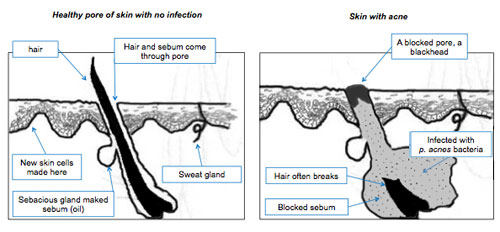Acne is not dangerous, but can leave skin scars. Human skin has pores (tiny holes) which connect to oil glands located under the skin. The glands are connected to the pores via follicles - small canals. These glands produce Sebum, an oily liquid. The sebum carries dead skin cells through the follicles to the surface of the skin. A small hair grows through the follicle out of the skin. Pimples grow when these follicles get blocked, resulting in an accumulation of oil under the skin.
The word acne comes from the word acme meaning "the highest point", which comes from the Greek akme meaning "point" or "spot" - it was originally mispelt, with an 'n' rather than an 'm' in 1835.
In humans, pimples tend to appear on the face, back, chest, shoulders and neck.
Simply put - skin cells, sebum and hair can clump together into a plug, this plug gets infected with bacteria, resulting in a swelling. A pimple starts to develop when the plug begins to break down.
Scientists from the Washington University School of Medicine found that there are good and bad strains of bacteria which determine the severity and frequency of developing acne. They explained in the Journal of Investigative Dermatology (March 2013 issue) that not all acne bacteria trigger pimples - in fact, one strain they identified can actually help keep the skin pimple-free.
There are various types of pimples
- Whiteheads - remain under the skin and are very small.
- Blackheads - clearly visible, they are black and appear on the surface of the skin. Remember that a blackhead is not caused by dirt. Scrubbing your face vigorously when you see blackheads will not help.
- Papules - visible on the surface of the skin. They are small bumps, usually pink.
- Pustules - clearly visible on the surface of the skin. They are red at their base and have pus at the top.
- Nobules - clearly visible on the surface of the skin. They are large, solid pimples. They are painful and are embedded deep in the skin.
- Cysts - clearly visible on the surface of the skin. They are painful, and are filled with pus. Cysts can easily cause scars.
How common is acne?
Dermatologists (skin specialists) say that approximately three-quarters of 11 to 30 year-olds will get acne at some time. Acne can affect people of all races and all ages. It most commonly affects adolescents and young adults, although there are people in their fifties who still get acne. According to Brown University, USA, approximately 17 million Americans are estimated to have acne at any one time.Although acne affects both men and women, young men suffer from acne for longer - probably because testosterone, which is present in higher quantities in young men, can make acne worse.
What causes acne?
Nobody is completely sure what causes acne. Experts believe the primary cause is a rise in androgen levels - androgen is a type of hormone. Androgen levels rise when a human becomes an adolescent. Rising androgen levels make the oil glands under your skin grow; the enlarged gland produces more oil. Excessive sebum can break down cellular walls in your pores, causing bacteria to grow.Some studies indicate that susceptibility to acne could also be genetic. Some medications which contain androgen and lithium may cause acne. Greasy cosmetics may cause acne in some susceptible people. Hormone changes during pregnancy may cause acne to either develop for the first time, or to recur.
A study published in February 2013 has suggested a link between a diet high in glycemic index foods and dairy products.

If you want to clear your acne now click the clearmyacnenow.
clearmyacnenow